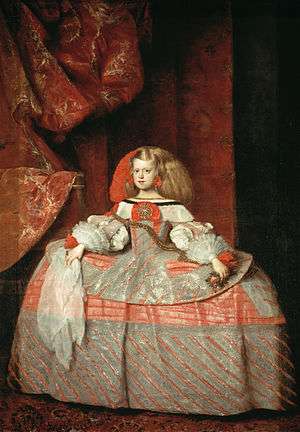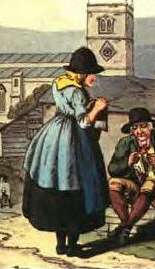Petticoat
_Cervantes_-_Miguel_Cabrera_-_overall.jpg)




A petticoat or underskirt is an article of clothing; specifically an undergarment to be worn under a skirt or a dress. The petticoat is a separate garment hanging from the waist (unlike the chemise).
In historical contexts (sixteenth to mid-nineteenth centuries), petticoat refers to any separate skirt worn with a gown, bedgown, bodice or jacket; these petticoats are not, strictly speaking, underwear as they were made to be seen. In both historical and modern contexts, petticoat refers to skirt-like undergarments worn for warmth or to give the skirt or dress the desired fashionable shape. In this context a petticoat may be called a waist slip or underskirt (UK) or half slip (US), with petticoat restricted to extremely full garments. Petticoat can also refer to a full-length slip in the UK,[1] although this usage is somewhat old-fashioned.
Petticoat is the standard name in English for any underskirt worn as part of non-Western clothing such as the lehenga with the sari.
History
The practice of wearing petticoats as undergarments was well established by 1585. Petticoats were worn throughout history by women who wanted to have the currently fashionable shape created by their clothing. The petticoats, if sufficiently full or stiff, would hold the overskirt out in a pleasingly domed shape and give the impression of a smaller waist than the wearer actually had. It would also complement the desired large bust.
Elaborately decorated petticoats were worn under open-fronted gowns and looped overskirts from the mid-16th century. Eighteen century petticoats of wool or silk were often quilted for additional warmth and were worn with matching short gowns or jackets, which could be fashioned like a man's jacket with military details and trimmings. These ankle-length petticoats remained a rural fashion, especially in the UK, into the 19th century and are a part of the traditional Welsh costume.
In the 18th century, among the upper class women of Europe and America, elaborate lacy petticoats were worn with elegant silk dresses, sometimes supported by whalebone frames. The Devil's Brother, the Laurel and Hardy film adaptation of Daniel Auber's comic opera Fra Diavolo, offers a glimpse of the intricate petticoats, corsets, and other undergarments worn in the 18th century, especially in a scene where actress Thelma Todd prepares for bed, assisted by a maid. Colored pictures, called "fashion plates", were used to advertise the popular dresses and lingerie of the 18th century, a practice that continued through the 19th century until the introduction of photography around 1840.
In the early 19th century, dresses became narrower and simpler with much less lingerie. Then, as the waltz became popular in the 1820s, full-skirted gowns with petticoats were revived in Europe and the United States. By the mid 19th century, petticoats were worn over hoops, which were placed over other underwear like a corset cover, a corset, and drawers. The popular novel Gone with the Wind provides considerable, detailed descriptions of these fashions. One scene in the 1939 film adaptation, the character played by Vivien Leigh gives a good idea of the layers of petticoats and underwear that were worn in the 1860s.
The sheer weight of the clothing, along with the tightness of the corsets, sometimes caused women to faint. The voluminous, layered Victorian petticoats were fashionable in the eras when "full-bodied" was associated with health, wealth, and belonging to a higher class in the social structure, while "skinny" was associated with sickness, poverty, and belonging to a lower class.
The use of multiple petticoats continued to be popular until the 1870s, when the bustle was introduced, resulting in a return of narrower skirts. Some full-skirted gowns with petticoats were revived in the 1890s into the early 20th century, but most women continued to wear relatively narrow skirts. The "Gibson Girl" look with white blouses and long, narrow skirts was very popular during the late 19th and early 20th century.
Modern petticoats
For the first two decades of the 20th century, multiple petticoats fell out of fashion; narrow, sometimes tight, skirts became more common. Then, in the late 1920s, chiffon dresses with several sheer petticoats became fashionable. With the Great Depression in the 1930s, narrow skirts returned and petticoats again were unpopular until the end of the decade when revived for some evening, prom, and wedding gowns. World War II, with its rationing and general shortage of materials, brought an end to petticoats.
Petticoats were revived by Christian Dior in his full-skirted "New Look" of 1947 and tiered, ruffled, stiffened petticoats remained extremely popular during the 1950s, especially with teenage girls. Most of the petticoats were netlike crinoline, sometimes made of horsehair. Increasingly, nylon chiffon, taffeta, and organdy were used in petticoats. Many department stores carried an extensive variety of styles and colors of petticoats until the early 1960s (a few clothing and department stores sold them as late as 1970). They were also available through the famous Sears and J. C. Penney catalogues. Typically, at least three single petticoats were worn, until manufacturers began making double and triple layer petticoats. A narrow slip was usually worn under the petticoats, especially the crinoline type, because they tended to be "scratchy".[2]
Edith Head designed a number of gowns and dresses, supported by multiple layers of petticoats, for actresses such as Grace Kelly and Doris Day, who appeared in Alfred Hitchcock films in the 1950s.[3] Dinah Shore frequently wore dresses with petticoats on her NBC television shows Actress Connie Stevens, who appeared in television series and movies, said she wore petticoats as long as possible because she had wide hips.[4] Other entertainers who often wore petticoats were Brenda Lee, Connie Francis, and Patti Page.
By the middle of the 20th century, the full petticoat was somewhat rare, having been commonly replaced by simple, ungathered underskirts/waist slips (UK) or half slips (US). However, petticoats were still worn for proms and weddings.
Ruffled white or unbleached cotton petticoats were a brief fashion under Prairie skirts in the 1970s, and remain a component of Western wear. Short, full petticoats in the 1950s style are also commonly worn by squaredancers.
There was a major attempt to revive separate petticoats in 1987. However, by that time, most women who wanted very full skirts for proms, parties, or weddings bought dresses or skirts with attached crinoline petticoats.
Petticoats today
Lately the full, tiered petticoat has made a small comeback in the alternative subcultures, especially the gothic and Lolita subculture. They have also been popular with some cross-dressers. Various petticoats have also been used in films and musicals dealing with the 1950s, such as Grease, West Side Story, Peggy Sue Got Married, and Back to the Future, as well as occasional vintage rock music festivals, especially in Germany.[5] Although the traditional purpose for the petticoat is no longer in fashion, the general design has stayed the same with minor alterations including ripping and/or the usage of bright or generally non-traditional colors to fit in with modern fashion.
Petticoats are also making a comeback due to recent trends towards lavish weddings and grandiose bridal attire. Petticoats are commonly worn under bridal gowns with full skirts as a means of maintaining the gown's intended silhouette.
Also, people who dress in period costumes have begun wearing petticoats for a more authentic look. A number of websites offer a great variety of petticoats for sale, while other websites show historic and modern photographs of petticoats, often worn by models.
The everyday use of petticoats in the 1950s and early 1960s appears to have passed.
Asian petticoats
It is the main undergarment worn with a sari. Sari petticoats usually match the color of the sari and are made of satin or cotton.[6] A notable difference between the western petticoat and sari petticoat is that the sari petticoat is rarely shorter than ankle length. In India, it is also called Inner Skirt [7] or an Inskirt.
Petticoats in popular culture
The phrase Petticoat Government has referred to women running government or domestic affairs. The phrase is usually applied in a positive tone welcoming female governance of society and home,[8] but occasionally is used to imply a threat to appropriate government by males, as was mentioned in several of Henry Fielding's plays.[9] An Irish pamphlet Petticoat Government, Exemplified in a Late Case in Ireland was published in 1780.[10] The American writer Washington Irving used the phrase in his Rip Van Winkle (1819) [11] Frances Trollope wrote Petticoat Government: A Novel in 1850.[12] Emma Orczy wrote Petticoat Government, another novel, in 1911.
Gilbert Keith Chesterton (1874-1936), mentions petticoat in a positive manner; to the idea of female dignity and power in his book, What's Wrong With the World, he states, “It is quite certain that the skirt means female dignity, not female submission; it can be proved by the simplest of all tests. No ruler would deliberately dress up in the recognized fetters of a slave; no judge would appear covered with broad arrows. But when men wish to be safely impressive, as judges, priests or kings, they do wear skirts, the long, trailing robes of female dignity The whole world is under petticoat government; for even men wear petticoats when they wish to govern.”[13]
United States President Andrew Jackson's administration was beset by a scandal called "The Petticoat Affair." The story was dramatized in the 1936 film The Gorgeous Hussy.
A 1943 comedy film called Petticoat Larceny depicted a young girl being kidnapped by grifters. In 1955, Iron Curtain politics were satirised in a Bob Hope and Katharine Hepburn film The Iron Petticoat. In the same year Western author Chester William Harrison wrote a short story "Petticoat Brigade" that was turned into the film The Guns of Fort Petticoat in 1957. Blake Edwards filmed a story of an American submarine filled with nurses from the Battle of the Philippines called Operation Petticoat.
Petticoat Junction is a CBS TV series that originally aired in 1963, ran for seven seasons, and achieved enduring success in syndication. The opening sequence featured a display of petticoats hanging on the side of a large railroad water tank where three sisters are skinnydipping. CBS has another series in the 1966-67 season called Pistols 'n' Petticoats.
References
- ↑ Oxford English Dictionary (1989) "A light loose undergarment... hanging from the shoulders or waist"
- ↑ Interview by R.E. Nylund
- ↑ American Movie Classics
- ↑ Interview with Connie Stevens, reported in www.pettipond.com
- ↑ Petticoat Pond
- ↑ "indiangarment.com Is For Sale".
- ↑ "How to wear saree perfectly - Glowpink". 26 March 2015.
- ↑ gynocentrism (19 September 2013). "Petticoat government (1702)".
- ↑ p.21 Campbell, Jill Natural Masques: Gender and Identity in Fielding's Plays and Novels Stanford University Press
- ↑ p.184 Higgins, Padraig A Nation of Politicians: Gender, Patriotism, and Political Culture in Late Eighteenth-Century Ireland University of Wisconsin Press 2010
- ↑ "Rip Van Winkle." p. 60
- ↑ Frances Milton Trollope (1850). Petticoat government: A novel, Volume 1. Henry Colburn. Retrieved 8 August 2011.
- ↑ Chesterton, Gilbert Keith (2007). What's Wrong With the World (Unabridged republication of edition: New York : Sheed & Ward, 1952; originally published: 1910 ed.). Mineola, New York: Dover Publication. p. 111. ISBN 978-0-486-45427-6.
External links
| Wikimedia Commons has media related to Petticoats. |
- Quilted Petticoat, 1750-1790, in the Staten Island Historical Society Online Collections Database
- Petticoat-Government in a Letter to the Court Lords (1702)